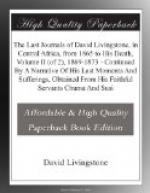A moment’s inspection of the map will explain the line of country to be traversed. Susi and Chumah had travelled with Dr. Livingstone in the neighbourhood of the north-west shores of Bangweolo in previous years. The last fatal road from the north might be struck by a march in a due N.E. direction, if they could but hold out so far without any serious misfortune; but in order to do this they must first strike northwards so as to reach the Luapula, and then crossing it at some part not necessarily far from its exit from the Lake, they could at once lay their course for the south end of Tanganyika.
There were, however, serious indications amongst them. First one and then the other dropped out of the file, and by the time they reached a town belonging to Chitambo’s brother—and on the third day only since they set out—half their number were hors de combat. It was impossible to go on. A few hours more and all seemed affected. The symptoms were intense pain in the limbs and face, great prostration, and, in the bad cases, inability to move. The men attributed it to the continual wading through water before the Doctor’s death. They think that illness had been waiting for some further slight provocation, and that the previous days’ tramp, which was almost entirely through plashy Bougas or swamps, turned the scale against them.
Susi was suffering very much. The disease settled in one leg, and then quickly shifted to the other. Songolo nearly died. Kaniki and Bahati, two of the women, expired in a few days, and all looked at its worst. It took them a good month to rally sufficiently to resume their journey.
Fortunately in this interval the rains entirely ceased, and the natives day by day brought an abundance of food to the sick men. From them they heard that the districts they were now in were notoriously unhealthy, and that many an Arab had fallen out from the caravan march to leave his bones in these wastes. One day five of the party made an excursion to the westward, and on their return reported a large deep river flowing into the Luapula on the left bank. Unfortunately no notice was taken of its name, for it would be of considerable geographical interest.
At last they were ready to start again, and came to one of the border villages in Ilala the same night, but the next day several fell ill for the second time, Susi being quite unable to move.
Muanamazungu, at whose place these relapses occurred, was fully aware of everything that had taken place at Chitambo’s, and showed the men the greatest kindness. Not a day passed without his bringing them some present or other, but there was a great disinclination amongst the people to listen to any details connected with Dr. Livingstone’s death. Some return for their kindness was made by Farijala shooting three buffaloes near the town: meat and goodwill go together all over Africa, and the liberal sportsman scores points at many a turn. A cow was purchased here for some brass bracelets and calico, and on the twentieth day all were sufficiently strong on their legs to push forwards.




